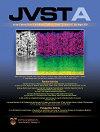Chemical vapor deposition of amorphous boron carbide coatings from mixtures of trimethylboron and triethylboron
IF 2.1
3区 材料科学
Q3 MATERIALS SCIENCE, COATINGS & FILMS
引用次数: 0
Abstract
Amorphous BxC films were deposited from the coreaction of triethylboron (TEB) and trimethylboron (TMB) at 700 °C in H2. We observed that combining both precursors allows us to balance their deposition kinetics and yields higher growth rates. Quantitative analysis by x-ray photoelectron spectroscopy shows that a wide range of B/C ratios between 0.7 and 4.1 could be obtained by varying the TEB:TMB ratio. Raman spectroscopy was used to assess the bonding in the films that gradually evolved from a structure similar to that of a-B, to a mixture of half-icosahedra embedded in a carbon matrix to a graphitic structure, as the carbon content increased. The addition of TMB in the gas phase was found to result in a decrease in elasticity and hardness but an improved adhesion, resulting in complex crack patterns upon cleaving, such as sinusoidal cracks and loops. On the one hand, the incorporation of carbon from TMB leads to an increasing contribution of the softer carbon matrix, to the detriment of polyhedral B–C structures, which in turn decreases Young’s modulus and hardness. On the other hand, it suggests that near the film-substrate interface, the presence of the carbon matrix affords a high density of strong carbon-based bonds, resulting in improved adhesion and preventing delamination of the coatings.用三甲基硼和三乙基硼的混合物化学气相沉积非晶态碳化硼涂层
以三乙基硼(TEB)和三甲基硼(TMB)为原料,在700℃的H2中共反应制备了无定形BxC薄膜。我们观察到结合这两种前体可以平衡它们的沉积动力学并产生更高的生长速率。x射线光电子能谱定量分析表明,通过改变TEB:TMB比值,可以得到0.7 ~ 4.1范围内的B/C比值。随着碳含量的增加,薄膜中的键合逐渐从类似于a- b的结构演变为嵌入碳基体的半二十面体混合物,再演变为石墨结构。发现在气相中添加TMB会导致弹性和硬度下降,但附着力改善,导致切割时出现复杂的裂纹模式,如正弦裂纹和环。一方面,TMB中碳的掺入导致较软碳基体的贡献增加,损害了多面体B-C结构,从而降低了杨氏模量和硬度。另一方面,这表明在薄膜-衬底界面附近,碳基体的存在提供了高密度的强碳基键,从而提高了附着力,防止了涂层的分层。
本文章由计算机程序翻译,如有差异,请以英文原文为准。
求助全文
约1分钟内获得全文
求助全文
来源期刊

Journal of Vacuum Science & Technology A
工程技术-材料科学:膜
CiteScore
5.10
自引率
10.30%
发文量
247
审稿时长
2.1 months
期刊介绍:
Journal of Vacuum Science & Technology A publishes reports of original research, letters, and review articles that focus on fundamental scientific understanding of interfaces, surfaces, plasmas and thin films and on using this understanding to advance the state-of-the-art in various technological applications.
 求助内容:
求助内容: 应助结果提醒方式:
应助结果提醒方式:


